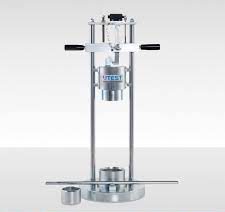Table of Contents
Introduction:
The application of load on the aggregates such as pavements result into the disintegration of the particles which may result into the loss of strength due to lack of interlocking ability and sudden shock. The load results into the decrease in the compressive strength of the aggregates. this test is usually performed to assess the use of aggregates in the pavement structures and the layers adopted during the road construction.
Related theory:
Toughness is defined as the ability of the material to resist the load applied on it. The load subjection of vehicles on the road surface results into the fissuring of the aggregate particles resulting into the loss of strength.
Therefore, the aggregates adopted should be tough enough to withstand the application of loads and this factor is determined through this test. It is the repulsion or resistance to a sudden load or impact applied which is varying from a normal gradually applied load.

Figure 1 impact testing machine
Standard:
IS-2386
Apparatus:
- Aggregates sample (10mm-12.5mm)
- Oven
- Sieves of IS standards (based on the aggregates size)
- Measuring cylinder
- Tamping rod
- Weighing balance
- Impact testing machine
Procedure:
- Weigh a certain amount of sample and oven dry it at a temperature of 110-115
- Sieve the aggregate sample to discard those which are not residing in our standard limits.
- Add up the aggregates in the measuring cylinder in three layers, each layer being filled by 1/3rd part by the tamping rod giving a total of 25 gentle blows per layer across the surface.
- After all the three layers the surface is scraped off for even layer on the top.
- The aggregate impact determining machine is than set up and aligned exactly vertical along the sample.
- The hammer is dropped by a height of 380mm from the aggregate surface freely, providing 15 blows on either side of the layer.
- The sample is then demolded and sieved through the IS Sieves (2.36). The fine particles are removed and the sample is weighed again determining the loss of the aggregates due to the applied impact.
Observations:
| Observations | Sample #1 | Sample #2 |
| Total dry weight of the sample (W1,gm) | ——— | ——— |
| Weight of sample passing through sieve #2.36 (W2,gm) | ——— | ——— |
| Aggregate impact value (%) | ——— | ——— |
Calculations:
Aggregate impact value (%) = ( W2/W1 )×100
Comments:
The classification is made through:
| Aggregate impact value | Classification |
| <20% | Excellent |
| 10-20% | Good |
| 20-30% | Fair for surfacing |
| >35% | Weak for surfacing |
The comments can be made on the basis of the results obtained.
Precautions:
- The hammer should be dropped freely.
- The drop height should be observed properly.
- The weighing balance should be accurate.





